Before IROB died a not entirely unexpected death, I had started discussing a concept I have labeled “biblio-sentimentality.” Biblio-sentimentality is the emotional attraction to books that have inscriptions, notes or items inside them that causes me to purchase such books, even when the content of the book may not be meaningful to me. I divide the items that inspire biblio-sentimentality into three categories: ephemera, or items left in books that have nothing to do with the book itself (which I discussed in this entry); inscriptions, which can be from the author or messages to a gift recipient; and marginalia, which includes notations in margins in books as well as highlighting and underlining. We often see books with particularly compelling items that tug at our biblio-sentimentality and we have to buy the book. We worry that the book is sad or lonely. We feel we need to rescue it.
(Mr OTC and I are well-matched in our near-animist capability of seeing emotions in inanimate objects. We see a well-loved book and think it is miserable because it was parted from its reader. We finally bought a new car after driving a 17-year-old Honda until the wheels nearly fell off and when we left it at the dealership I was afraid the car, a she-car, would be bereft because we abandoned her for a shinier and more reliable replacement. We frequently try to appease our home, which has eldritch elements that at times seem threatening but can be tamped down if we keep our complaints to ourselves.)
This entry will show a couple my favorite examples of marginalia in my collection.
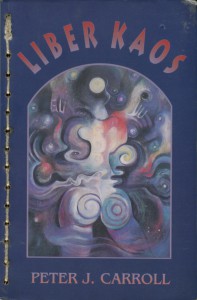 The first is actually a hybrid of sorts, an excellent example of marginalia and book customization. This edition of Liber Kaos is Mr OTC’s book and he bought it because it just seemed nuts that someone who took this much time to reinforce a book binding would willingly get rid of it.
The first is actually a hybrid of sorts, an excellent example of marginalia and book customization. This edition of Liber Kaos is Mr OTC’s book and he bought it because it just seemed nuts that someone who took this much time to reinforce a book binding would willingly get rid of it.
The book just seemed too personalized to have been left at the used book store for anything other than a very dire reason. Someone carefully measured out near-equidistant spots for holes, took an awl and carefully punctured the cover and pages, and laced waxed twine through the holes. I’ve never seen a book customized this way and it points to a reader who, at some point, felt this book to be very important.
I don’t think we have too many examples of customized books but I also have swathes of books that I haven’t examined in a while and sometimes Mr OTC slides books into shelves before I am able to inspect and inventory them. But in all my time in book accumulation, I haven’t seen this sort of careful alteration.
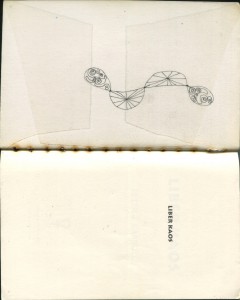 The book technically has an inscription of sorts. On the page before the title page is a weird little symbol the original owner drew. There are a couple of smaller ones throughout the book. It seems like a rough version of the spirals on the cover. I haven’t read this book so the drawing may be full of symbology that makes sense when considering the content of the book. To my uneducated eye, these are deliberate drawings in the book, not just random doodles.
The book technically has an inscription of sorts. On the page before the title page is a weird little symbol the original owner drew. There are a couple of smaller ones throughout the book. It seems like a rough version of the spirals on the cover. I haven’t read this book so the drawing may be full of symbology that makes sense when considering the content of the book. To my uneducated eye, these are deliberate drawings in the book, not just random doodles.
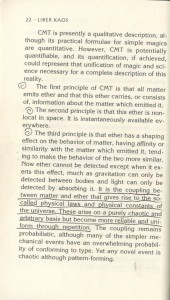 Click on any of the images in order to see a larger version.
Click on any of the images in order to see a larger version.
Throughout the book there are little spirals before paragraphs the previous owner found significant and underlining of important passages.
The underlined text in this book says: “It is the coupling between matter and ether that gives rise to the so-called physical laws and physical constants of the universe. These arise on a purely chaotic and arbitrary basis but become more reliable and uniform through repetition.”
I wish I could say this means something to me, too. This sort of thing just isn’t my bag and it sort of reads to me now the way the Bible did when I was ten years old. I’m not demeaning this text – after all I have confessed to being the sort of woman who worried that her beater car was sad when traded in for a newer model. But it is interesting nonetheless to imagine the person, and for some reasons I see the previous owner as a man, reading this passage and finding it to be useful. Did this help him? Did he incorporate these as some sort of instructions that helped him master the material world? And does the book resent now being in a household wherein at least one of the adults looks at this and shrugs?
 The next example is one of my favorite books in the house, rating up there with my first edition of Sleeping Beauty from the Burns Archive. This is a book that I “get” from an author I respect and enjoy. That helps. (By the way, I will be discussing In the Sky
The next example is one of my favorite books in the house, rating up there with my first edition of Sleeping Beauty from the Burns Archive. This is a book that I “get” from an author I respect and enjoy. That helps. (By the way, I will be discussing In the Sky by Octave Mirbeau as translated by Ann Sterzinger here soon – I need to add this version of The Torture Garden
to the list, as well. I’m sort of surprised I haven’t discussed it here already.)
But mostly I love this book because of the careful notations and highlighting done by the previous owner. She left her name in the front of the book and that name let me know she was likely an immigrant or first generation American. Her handwriting is a thing of beauty and reminds me of the handwriting one of my college professors, a woman from India who was a gifted mathematician.
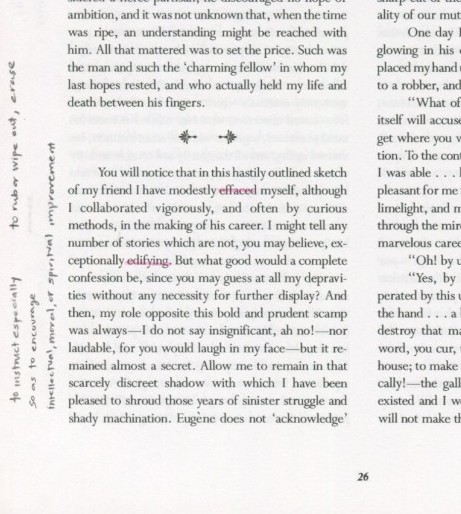 Something I found very interesting was the previous owner’s attention to vocabulary. One can assume that a woman who reads carefully an Octave Mirbeau title has a certain level of erudition, and the previous owner of this book definitely read this book very carefully. But more arcane vocabulary tripped her up and she highlighted the words and added their definitions in the margin in her delightful print.
Something I found very interesting was the previous owner’s attention to vocabulary. One can assume that a woman who reads carefully an Octave Mirbeau title has a certain level of erudition, and the previous owner of this book definitely read this book very carefully. But more arcane vocabulary tripped her up and she highlighted the words and added their definitions in the margin in her delightful print.
effaced: to rub or wipe out, erase
edifying: to instruct especially so as to encourage intellectual, moral, or spiritual improvement.
There are other examples – on another page, “fatuity” is defined. She only highlighted words that were relatively uncommon and were I not somewhat fatuous myself I could see myself looking up “fatuity.”
The best parts of this book for me are the passages she outlined in whole, passages that meant something to her.
“Know how to kill. That is to say, how to work the human body like a sculptor works his clay or piece of ivory, and evoke the entire sum, even prodigy of suffering it conceals, in the depths of its shadows and its mysteries… Science is required, variety, taste, imagination…genius, after all.
…
The Occidental snobbery which is invading us, the gunboats, rapid-fire guns, long range rifles, explosives… what else? Everything which makes death collective, administrative and bureaucratic…”
I have no intention of revealing her full name here, because this woman still lives in the USA and once you sell a book to a used book store you don’t need an obsessive like me linking you to it years later, but the woman who owned this book before I found it has a last name exclusive to a certain Far East Asian country. That country experienced a lot of turmoil due to Western opinions on democracy. Therefore I find it all the more interesting that she highlighted this passage that criticizes the “Occidental” methods of killing as being fast, empty and administrative in execution.
Lest anyone worry that I am a creepy book stalker, I have a habit of looking up the names of anyone who leaves a bookplate, stamp or name inscription in their books (and when I die and all my books end up in a used book store, I hope the circle remains unbroken). I have books in my collections that came from notable people and I would not have known that had I not quickly Googled. After looking up her name I’ve never looked for her again. But it’s a part of biblio-sentimentality that I feel a strange connection to this woman who loved this book, whose own history may have permitted her a wholly different reading of this book, an experience that influences me, even if it is not my own experience.
This copy of Octave Mirbeau’s Torture Garden is probably my best example of biblio-sentimentality because even though this is an excellent book that I would have owned in some form one way or another, the hands of the previous owner left extraordinary value on its pages.
My next installment in this series will cover some of the more interesting inscriptions Mr OTC and I have accumulated over the years. Again, please share any examples of biblio-sentimentality you may own, or examples of particularly interesting marginalia you’ve seen.
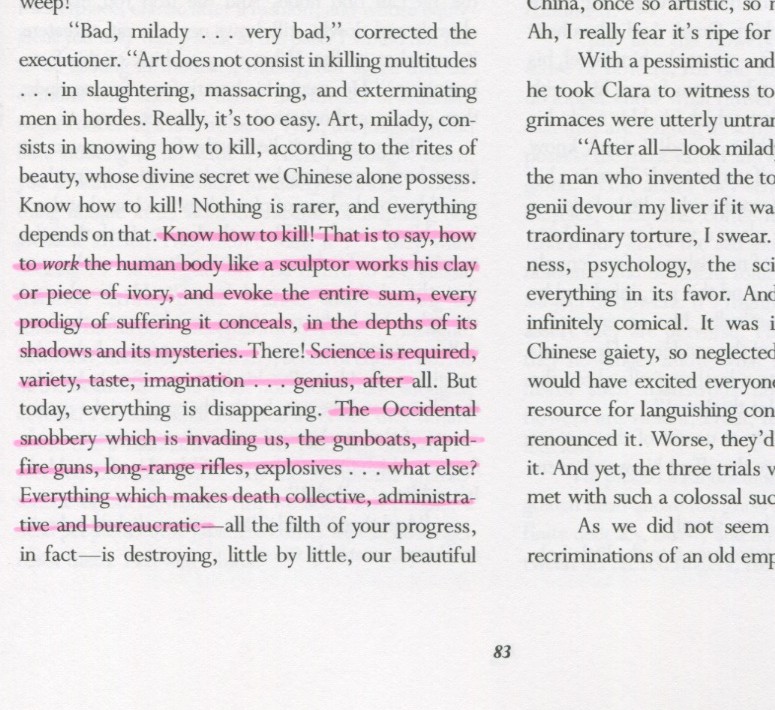
I’m actually putting the finishing touches on my own review of IN THE SKY. It’s cool to see you were involved in getting that made.
I really liked THE TORTURE GARDEN, but reactions to it seem to be all over the place. Fascinating that your used copy had this kind of history behind it.
I have a lot of used books, but most of them are from library sales, so they rarely end up having anything like this inside them.